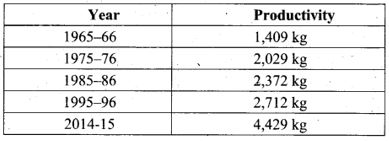Samacheer Kalvi 9th Social Science – Economics Unit 4 Book Back Answers:
Samacheer Kalvi 9th Standard New Social Science Book Back 1 Mark and 2 Mark Question & Answers PDF uploaded and available below. Class 9 New Syllabus 2021 to 2022 Book Back Question & Answer available for both English and Tamil Mediums. Class 9 Social Economics Book Unit 4 – Tamilnadu Agriculture Answers/Solutions are provided on this page. 9th Std Social Science History Book portion consists of 11 units, Geography Book portion consists of 8 units, Civics book portion consists of 6 units, and Economics book portion consists of 5 units, All Social Book Back One, and Two Mark Solutions are given below.
Check Unit wise and Samacheer Kalvi 9th Social Science Book Back Solutions Answers PDF format for Free Download. English, Tamil, Maths, Science, and Social Science Book Back Question and Answer is available in PDF. Class 9th Standard Social Book Back Answers PDF. Check Social Science – History, Geography, Civics, Economics Answers below. See below for the 9th New Syllabus Book Back guide/Answers free PDF download:
Samacheer Kalvi 9th Social Science Book Back Solutions PDF:
9th Social Subject 1 Mark and 2 Mark Solutions PDF available below. Click the Download option to download the book back 1 Mark & 2 Mark questions and answers. Take the printout and use it for exam purposes. Samacheer Kalvi 9th Economics Unit 4 Answers are given below.
Economics Book Back Answers
Unit 4 – Tamilnadu Agriculture
I. Choose the correct answer:
1. Irrigated land surface out of cultivable land is
(a) 27%
(b) 57%
(c) 28%
(d) 49%
Answer:
(b) 57%
2. Out of the following which is not a food crop?
(a) Bajra
(b) Ragi
(c) Maize
(d) Coconut
Answer:
(d) Coconut
3. The productivity of paddy during the year 2014-2015
(a) 3,039 kg
(b) 4,429 kg
(c) 2,775 kg
(d) 3,519 kg
Answer:
(b) 4429 kilogram
4. Both agricultural productivity and food productivity has ……..
(a) decreased
(b) not stable
(c) remained stable
(d) increased
Answer:
(d) Increased
5. The North-East monsoon period in Tamilnadu ………
(a) August – October
(b) September – November
(c) October – December
(d) November – January
Answer:
(c) October – December
II. Fill in the blanks.
- The major occupation of people in Tamilnadu is ……..
- Tamilnadu receives rainfall from the ……. monsoon.
- The total geographical area of Tamil Nadu is …….. hectares.
Answers:
1. Agriculture
2. Northeast
3. 30 lakh and 33 thousand
III. Match the following:

Answers:
1. (e): 2. (d): 3. (c): 4. (b): 5. (a)
IV. Give short Answers
1. Give two examples for each food crop and non-food crops.
Answer:
Example for food crops: Paddy, Maize Example for non-food crops: Coconut, Cotton.
2. What are the factors responsible for the changes in cropping area?
Answer:
The size of the total cropping land in Tamil Nadu is 4,544 thousand hectare and this keeps on changing every year. Sufficient rains at the proper period will increase this extent of land. Failure or shortage in rainfall leads to the reduction of land usage for cultivation. .
3. Who monitors the quantity and quality of ground water?
Answer:
The Union Ground Water Board is constantly monitoring the level and nature of ground water. This continuous monitoring has categorized the Panchayat Union (blocks) in terms of the amount of groundwater used. 139 blocks in Tamilnadu are identified as excessive users of groundwater and 100 blocks as nearing the stage of excessive usage of groundwater. 11 blocks have been identified with reduced water quality. Only 136 blocks have enough quantity and quality water for usage.
4. Tabulate the productivity of paddy from 1965 to 2015.
Answer:
5. On what factors does crop cultivation depend? List out the factors on which crop cultivation depend.
Answer:
Crop cultivation depends on – rainfall, availability of water, weather and market prices.
6. Differentiate small and marginal farmers.
Answer:
| Small Farmers | Marginal Farmers |
| Small farmers cultivate in lands ranging from 1 -2 hectares. | Marginal farmers cultivate in lands within 1 hectare. |
Other important links for Samacheer Kalvi 9th Book Back Answers:
Click Here for the 9th new social science book back Answers/Solutions – 9th Social Book Back Answers

